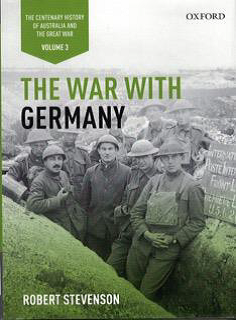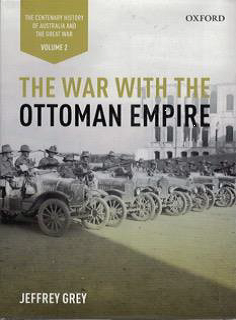These are volumes two and three of the Oxford Centenary History of the Great War, and we are most grateful to the publisher for the review copies. The first volume, The War in the Air, has been reviewed in an earlier Newsletter. Two more volumes are projected, one of which, The War at Home, is already published.
Professor Grey, the President of the Society for Military History, oversees the most important scholarly organization in the field of military history, with more than 2,500 members worldwide. His many previous books have been to a uniformly high standard. Dr Stevenson, a former Army officer, has written a history of the 1st Australian Division in the Great War.
Both books are dispassionate and analytical. Each draws on the extensive use of new archival sources and recent research. They are written as history, not based on prior assumptions but on careful assessment. And so we might well ask how they relate to Charles Bean’s magisterialOfficial History. Bean (and his co-authors) sought to include the soldiers’ story in his narrative and indeed sought the human-interest angle. His pioneering work was a great achievement even if the narrative at times tended to glorify achievements without necessarily explaining all the intricate complexities of the conflict. His history was justifiably popular to veterans and their families. The Oxford series is simultaneously narrative and thematic. It concentrates on military performance and the balance between the opponents. Its perspectives are more strategic and operational than tactical. Its style is far from the artificial drama of a Peter Fitzsimons or from the narrative reporting of Les Carlyon. Both volumes are written in an unemotional clear and easy-to-comprehend style. If they follow a model, I suspect it might well be that of the late Barbara W. Tuchman who “wanted her reader to turn the page and keep on turning to the end [which] is accomplished only when the narrative moves steadily ahead, not when it comes to a weary standstill.” 15 RUSI VIC June 2016
The Ottoman volume is particularly notable for its equitable consideration of ‘the other side of the hill’. The German takes the unusual but effective approach of considering both the New Guinea and Western Front theatres.
These volumes will stand alongside Bean’s and supplement them ideally. Perhaps they will not ascend to the popularity of the works of some of the authors cited above – but they should. Australians deserve sober analyses of the Great War: here they have them delivered with authority. These volumes will stand the test of time.
The series has good maps (sadly not in colour), is well indexed and clearly refers to its sources. It is supplemented with well-chosen photographs. The bibliographic essay in each volume is a succinct summary of the scholarship in these areas and is alone worth the price.
Read these volumes to understand Australia and the Great War.
Reviewed For RUSIV by Major General Mike O’Brien CSC


Contact Royal United Services Institute about this article.






